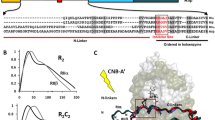Abstract
Dipyridamole activates in vitro type II CAMP-dependent protein kinase. This agent stimulates the autophosphorylation of the regulatory subunit in the presence of CAMP but not so in the absence of the cyclic nucleotide. The activation was also observed with exogenous substrates such as casein, histone 2A and MAP 2. This stimulation did not seem to be related to the cAMP binding to the R II subunit of the enzyme. Competition binding experiments showed that dipyridamole does not compete with adenosine for the A1 receptor. The results suggest that the reported regulatory properties of dipyridamole on lipid metabolism (González-Nicolás et al. Int J Biochem 21: 883–888, 1989) might be mediated through a direct action — an activation — on the catalytic subunit of a cAMP-dependent protein kinase.
Similar content being viewed by others
References
Nelson JA, Drake S: Potentiation of methotrexate toxicity by dipyridamole. Cancer Res 44: 2493–2496, 1984
Cabral S, Leis S, Bover L, Nembrot M, Mordon J: Dipyridamole inhibits reversion by thymidine of methotrexate effect and increases drug uptake in Sarcoma 180 cells. Proc Natl Acad Sci USA 81: 3200–3208, 1984
Shi MM, Joung JD: (3H) dipyridamole binding to nucleoside transport from guinea-pig and rat lung. Biochem J 240: 879–883, 1986
Van Mouwerik TJ, Pangallo CA, Willson JKV, Fischer PH: Augmentation of methotrexate cytotoxicity in human colon cancer cells achieved through inhibition of thymidine salvage by dipyridamole. Biochem Pharmacol 36: 809–814, 1987
Ullman BK, Kaur K: Biochemical effects of dipyridamole on purine overproduction and excretion by mutant murine T-lymphoblast. J Biol Chem 258: 9620–9622, 1983
González-Nicolás J, Jiménez J, Page-Peñuelas A, Zabala MT, Moreno FJ: Regulation of lipid metabolism by dipyridamole and adenosine antagonists in rat adipocytes. Int J Biochem 21: 883–888, 1989
Schwabe U, Schonhofer P, Ebert R: Facilitation by adenosine of the action of insulin on the accumulation of adenosine 3′,5′-monophosphate, lipolysis, and glucose oxidation in isolated fat cells. Eur J Biochem 46: 537–545, 1974
Rao AK, Walsh PN: Acquired quantitative platelet disorders. Clin Haematol 12: 201–217, 1983
Weishaar RE, Burrow SD, Kobylarz DC, Quade MM, Evans DB: Multiple form of cyclic nucleotide phosphodiesterase in cardiac and smoth muscle and in platelets. Isolation, characterization, and effects of various reference phosphodiesterase inhibitors and cardiotonic agents. Biochem Pharmacol 35: 787–800, 1986
Rodbell M: Metabolism of isolated fat cells. J Biol Chem 239: 375–380, 1964
McKeel DW, Jarret L: Preparation and characterization of plasma membrane fraction from isolated fat cells. J Cell Biol 44: 417–432, 1970
Shelanski ML, Gaskin F, Cantor CR: Microtubule assembly in the absence of added nucleotide. Proc Natl Acad Sci USA 70: 765–768, 1973
Vallee RB: On the use of heat stability as a criterion for the identification of microtubule-associated proteins. Biochem Biophys Res Common 133: 128–133, 1985
Reiman EM, Walsh DA, Krebs EG: Purification and propertiies of rabbit skeletal muscle adenosine 3,5′-monophosphate-dependent protein kinases. J Biol Chem 246: 1986–1995, 1971
Fischer EH, Krebs EG, Kent AD: Preparation of crystalline muscle phosphorylase b and conversion to phosphorylase a. Biochem Prep 6: 68–73, 1958
Fisher EH, Krebs EG, Colwick SP, Kaplan NO: Muscle phosphorylase b. Methods Enzymol 5: 369–373, 1972
Krebs EG, Love DS, Bratvold GE, Trayser KA, Meyer WL, Fisher EH: Purification and properties of rabbit skeletal muscle phosphorylase b kinase. Biochemistry 3: 1022–1036, 1964
Company M, Zuloaga J, Martinez P, Jimenez JS: A stopped-flow assay for glycogen phosphorylase appropriate to measure catalytic activity at high enzyme concentrations. Anal Biochem 173: 235–240, 1988
Beavo JA, Bechtel PJ, Krebs EG: Preparation of homogeneous cyclic AMP-dependent protein kinase and its subunits from rabbit skeletal muscle. Methods Enzymol 38: 299–308, 1974
Laemmli UK: Cleavage of extructural proteins during the assembly of the head of bacteriophge T4. Nature (London) 227: 680–685, 1970
González-Nicolás J, Jiménez JS. Moreno FJ: Different phosphorylation behaviour of regulatory subunit isoforms of type II cAMP-dependent protein kinase from bovine heart. Mol Cell Biochem 96: 25–33, 1990
Bruns RF, Daly JN, Snyder SH: Adenosine receptors in brain membranes: binding of N6-cyclohexyl (3H) adenosine and 1,3-diethyl-8-(3H) phenylxanthine. Proc Natl Acad Sci USA 77: 5547–5551, 1980
González-Calero G, Martin M, Cubero A, Andrés A: Bovine brain coated vesicles contain adenosine A1 receptors. Presence of adenylate cyclase coupled to the receptor. J Neurochem 55: 106–113, 1990
Gilman AG, Murad F: Assay of cyclic nucleotides by receptor protein binding displacement. Methods Enzymol 38: 49–61, 1974
Erlichman J, Rangel-Aldao R, Rosen OM: Reversible autophosphorylation of the type II cAMP-dependent protein kinase: Distinction between intramolecular and intermolecular reactions. Methods Enzymol 99: 176–184, 1983
Rangel-Aldao R, Rosen OM: Mechanism of self-phosphorylation of adenosine 3′:5′-monophosphate-dependent protein kinase from bovine cardiac muscle. J Biol Chem 251: 7526–7529, 1976
Fain JN, García-Sainz JA: Adrenergic regulation of adipocyte metabolism. J Lipid Res 24: 945–966, 1983
Tipper JP, Witters LA: In vitro phosphorylation and inactivation of rat liver acetyl-CoA carboxilase purified by avidin affinity chromatography. Biochem Biophys Acta 715, 162–169, 1982
Fain JN: Regulation of lipid metabolism by cyclic nucleotides. In: Kebabian JW, Nathanson JA (eds.) Handbook of experimental pharmacology. Springer-Verlag, Heidelberg. Vol 58/11 1982, pp 89–150
Villalba M, Kelly KL, Mato JM: Inhibition of cyclic AMP-dependent protein kinase by the polar head group of an insulin-sensitive glycophospholipid. Biochim Biophys Acta 968: 69–76, 1988
Saltiel AR, Cuatrecasas P: Insulin stimulates the generation from hepatic plasma membranes of modulators derived from an inositol glycolipid. Proc Natl Acad Sci USA 83: 5793–5797, 1986
Saltiel A: Insulin generates an enzyme modulator from hepatic plasma membranes: Regulation of 3′,5′-monophosphate phosphodiesterase, pyruvate dehydrogenase and adenylate cyclase. Endocrinology 120: 967–972, 1987
Malchoff CD, Huang L, Gillespie N, Villar-Palasí C, Schwartz CF, Cheng K, Hewlett EL, Larner J: A putative mediator of insulin action which inhibits adenylate cyclase and adenosine 3′,5′-monophosphate-dependent protein kinase: partial purification from rat liver: Site and kinetic mechanism of action. Endocrinology 120: 1327–1337, 1987
Author information
Authors and Affiliations
Rights and permissions
About this article
Cite this article
Jiménez, J.S., Lechuga, C.G., Alonso, G. et al. Dipyridamole stimulates types II cAMP-dependent protein kinase in vitro . Mol Cell Biochem 109, 9–15 (1992). https://doi.org/10.1007/BF00230868
Received:
Accepted:
Issue Date:
DOI: https://doi.org/10.1007/BF00230868




